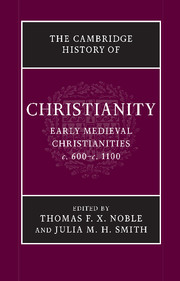Book contents
- Frontmatter
- Introduction: Christendom, c. 600
- Part I Foundations: Peoples, Places, and Traditions
- Part II Christianity in Confrontation
- Part III Christianity in the Social and Political Order
- Part IV Christianity as Lived Experience
- Part V Christianity: Books and Ideas
- Conclusion: Christendom, c. 1100
- Bibliographies
- Index
- References
Introduction: Christendom, c. 600
Published online by Cambridge University Press: 28 March 2010
- Frontmatter
- Introduction: Christendom, c. 600
- Part I Foundations: Peoples, Places, and Traditions
- Part II Christianity in Confrontation
- Part III Christianity in the Social and Political Order
- Part IV Christianity as Lived Experience
- Part V Christianity: Books and Ideas
- Conclusion: Christendom, c. 1100
- Bibliographies
- Index
- References
Summary
The Kingdom and the kingdoms
A little after 680 CE, Julian, bishop of Toledo, the capital of the Visigothic kingdom of Spain, was challenged to answer a constant objection made by the Jews against Christianity. Christians were misguided to think that, in the person of Jesus of Nazareth, the Messiah – the “Christ,” the Anointed One – had come. The Messiah had not come. The world was only five thousand years old. The sixth age in which the Messiah would arrive had not yet even begun. The recent centuries lacked meaning. They were a blank space, a time of waiting for the arrival of the true Christ – the Anointed One of God.
To the bishop of Toledo, his imagined Jewish interlocutors could not have been more wrong. History was already tinged with excitement. The Messiah had come. Christ had been born in Bethlehem in the days of the Emperor Augustus. His coming to earth had left a palpable trace. For it had coincided with a moment of almost supernatural quiet, throughout the Mediterranean world, associated with the foundation of the Roman Empire. Civil wars ceased. Peace returned to the cities. Relieved of military emergencies, the civilian population returned to the fields: “and the business of war was delegated to the Roman legions alone, to be conducted against barbarian nations.” For Julian, the peace of the Roman world in the age of Augustus, now over six centuries in the past, had been nothing less than the footprint on time of the incarnate God. The peace of Rome itself had not lasted.
- Type
- Chapter
- Information
- The Cambridge History of Christianity , pp. 1 - 18Publisher: Cambridge University PressPrint publication year: 2008



